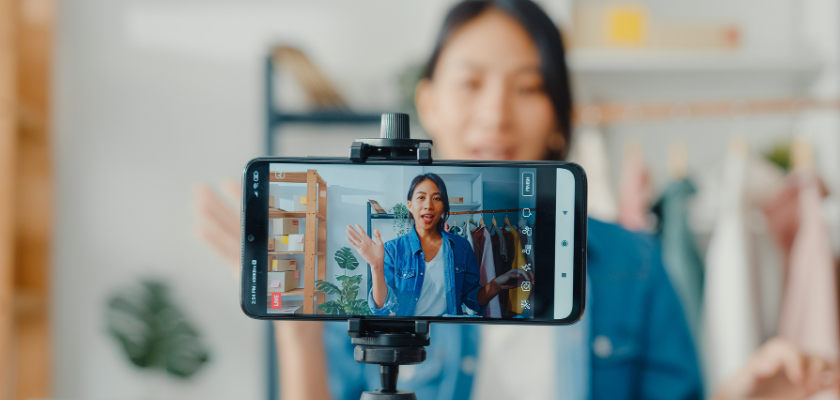
Micro Influencer Marketing: The New Wave of Authentic Brand Growth
Influencer marketing has become an irreplaceable tool among the current brand communication approaches, offering businesses a number of potent tools to engage with the target audience.
It seems that influencer marketing has always been a part of advertising with different celebrities advocating for brands. Along with other marketing tools that such agencies as Multiplayer and gamified.marketing provide customers with, influencer marketing plays a significant role for brands.
However, the ways of how influencer marketing is utilized underwent significant changes from simply attracting the attention of ad viewers to being a means of creating authentic connections and increasing the trust level. Every industry, from multinational corporations to smaller firms, has embraced influencer marketing as a way of promoting their brands, raising awareness of products, and building better connections with their consumers.
Influencers have become more selective than ever, and brands are equally selective when choosing the influencers with whom to work. It is not enough anymore to sign a celebrity and put their face on billboards or produce a video on social networks, there are more factors that need to be taken into account than just popularity.
The goal is no longer to have the largest audience possible but instead to make sure that the audience is engaged and sees the authentic connection between the influencer and the brand. As consumers become more selective with whom and what they want to interact with, influencers who can give their audience genuine content and build rapport are a precious asset. Influencer marketing is an increasingly relevant solution in the face of growing disapproval for traditional advertising, based on trust that influencers believe in a brand they advocate for.
The changes in influencer marketing are also connected to the overall trends in brands’ marketing spending. As the data presented below proves, a large portion of brands raised their budgets for influencer marketing in recent years.
Increasingly, firms are no longer approaching influencers as a medium for advertising their products, but as a long-term resource for customer acquisition and retention. What started as a small-scale experiment has turned into an essential component of brands’ marketing and this trend is set to grow.
The Current State of Influencer Marketing
Imagine entering a room with brand marketers engaged in the discussion of their best practices. One topic would surely dominate the conversation: influencer marketing.
For years, it has been the center of digital marketing and has not changed since. It can be stated now that influencer marketing is not only a trend but a key component of current and future marketing.
The numbers speak for themselves. An impressive 84,8% of the respondents in the survey have a positive attitude towards influencer marketing considering it highly effective. What is even more interesting is that despite still being extremely high it is just a bit lower than 90% in 2022. It is not a decrease in trust, but brands are possibly no longer interested in simply gathering large numbers of views but are looking for deeper associations. The influencer marketing trend has seen a shift from quantity to quality, in other words, brands are investing more in the right influencers that reflect the values of a brand rather than going for influencers with larger follower numbers.
This strategic shift is evident in how brands are allocating their budgets. According to the statistics of 2017, only 37% of all brands had a separate budget for influencer marketing. As we fast forward to 2024, that percentage has increased tremendously to 85.8%. Such growth has a lot to say about the sector’s evolution and its assimilation into the broader marketing environment. But what is behind this change?
There are many ways in which marketing can be done, and many different aspects which can influence the outcome. Perhaps brands are turning to influencer marketing now more than ever because of economic instability and changes in consumer behavior. Indeed, currently, consumers rely more on influencers than on ads, therefore budget distribution has also changed. Why spend on other types of marketing, when influencers can bring much better results? The numbers speak for themselves – 59,4% of those survey respondents who used influencer marketing before claimed that they were planning to increase the amount of money allocated for influencer marketing.
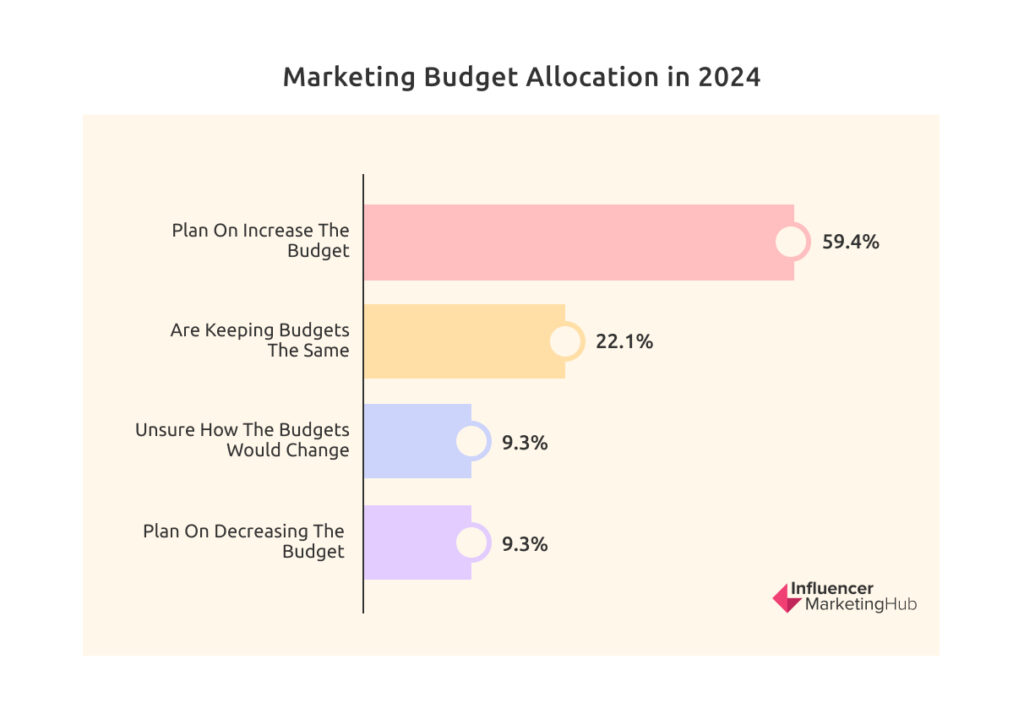
Brands are changing how they spend on influencer marketing, and there isn’t a single strategy that works for everyone. It should also be noted that the amount of money spent on influencer campaigns also differs: larger brands allocate more funds, and those who have already implemented such campaigns and seen the results, are ready to spend even more. 8,9% of brands are investing more than $50,000 annually on influencer marketing while nearly half of the brands – 47.4% – are investing $10,000 or less. This lower spending is more widespread among small businesses or companies that are just starting to explore influencer marketing. On the other hand, there is a group of brands that invest much more. The overall spending is rising rapidly and in 2024 14.5% of brands were allocating more than $500,000 annually, a figure that was only 11% the year before.

There is even a growing divergence between these two groups and this shift demonstrates that influencer marketing is not a universal solution and brands are gradually finding out how to operate based on their success.
The above-mentioned budgets also affect the way how brands approach the choice of influencers. Companies are targeting the correct influencers for particular tasks and do not necessarily go for influencers with the largest number of followers. The number of influencers’ followers matters, but perhaps not in the way that many people used to think about it. The amount of brands that are now employing nano-influencers (with followers between 1K and 10K) has risen, and 44% of the respondents chose them as their type compared to only 17.4% (which decreased from 19%) choosing macro-influencers (100K-1M followers). It is no longer about the number of followers an influencer has but about the number of people who are truly influenced by that influencer. This means that marketers target those who can develop better and more authentic communication with the target groups of customers.
But what if the influencer wasn’t human at all? Virtual influencers are an idea that is slowly starting to entice marketers in a way that seems almost sci-fi. These artificial personas, created by AI, are revolutionizing the whole concept of influencers. In fact, almost 61% of respondents said they have already collaborated with virtual influencers and this figure is constantly increasing. Brands are attracted to these digital personas because they are easily manageable and very consistent, something that even the most effective human influencer cannot guarantee. For instance, Magalu turned into a fashion icon and virtual influencer with more than 31 million followers at peak across social networking platforms. Her journey has shown that virtual influencers can be as effective as traditional celebrities’.
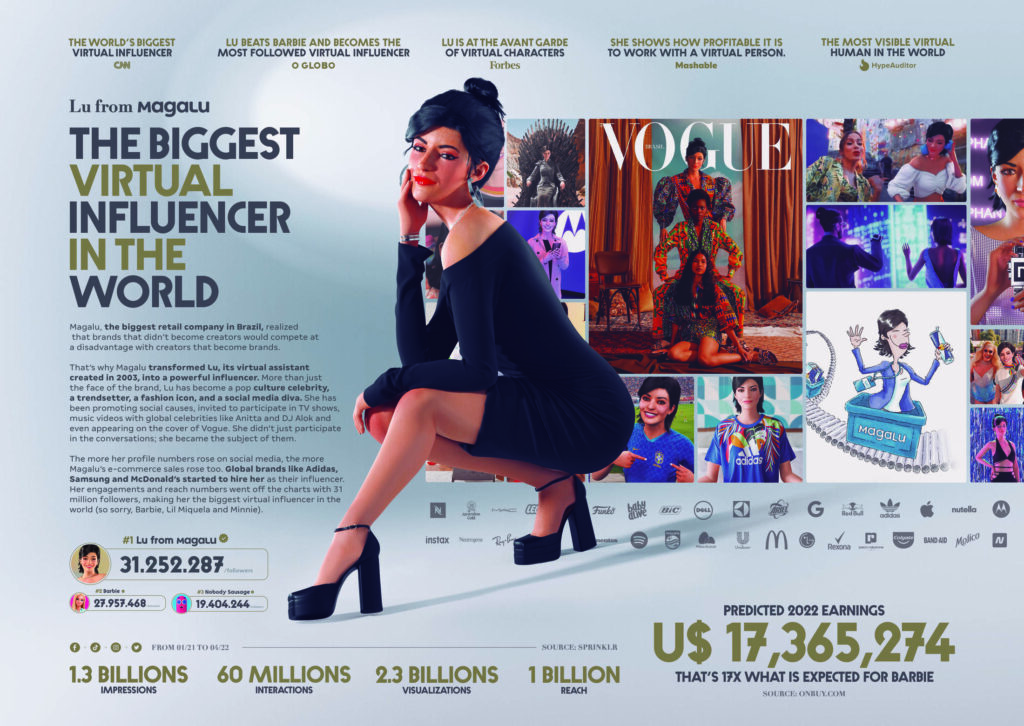
What does all this mean for the future? There are no more distinct differences between human and virtual influencers. Consumers are more sophisticated, technology is rapidly developing and so brands need to be adaptable, use the latest insights, and be ready to try new things. AI and Machine Learning are no longer luxuries—they are essential in determining who the influencers are and how to best reach them. More than 63% of marketers are expecting to incorporate these technologies into their influencer marketing. All these technological advancements are a distinctive feature of our time and it’s clear that brands must keep track of them in order to stay relevant in an increasingly competitive market
Influencer marketing will continue to evolve and the success of the strategy in the future will depend on how creative it will be. Even now, the classic approach remains the most popular, but brands are gradually beginning to open up to new opportunities – with the help of smaller, but more appropriate influencers or through the use of virtual avatars who are not burdened by physical constraints. What is for sure is that influencer marketing, in all its forms, will remain one of the main marketing strategies. The companies that adapt to these changes, gain from these experiences, and incorporate the latest technologies will definitely be the pioneers of the next phase of digital marketing.
Nano- and Micro-Influencers. Smaller Voices Equals Bigger Marketing Waves?
While influencer marketing has grown into a multi-billion dollar market, there is a new type of influencer that is changing the way brands engage with customers. These are not the celebrities or the people who became famous overnight through social media platforms, these are the nano- and micro-influencers – those who have fewer followers than average, but are far more influential. It is them who are turning their focus back to real interaction, communication, and relations.

The Significance of Audience Engagement Over Size
It could seem that nano-influencers with less than 5,000 followers are not the best option for the replacement of mega-influencers, who have millions of followers. But this could not be further from the truth. Nano-influencers are more efficient in terms of being able to establish deeper connections with their audience and turn every comment, like, or message into a genuine response to the content.
Nowadays, brands prefer to choose influencers with a smaller but more engaged audience. It includes micro-influencers with followers ranging from 10,000 to 50,000, who are also considered part of this trend. They have higher engagement rates and their followers trust them more. It makes them very valuable, especially for brands that are willing to spend more money and want to build long-term relationships without having to pay the enormous prices that come with the use of mega influencers.
Engagement Over Reach
While the numbers can be impressive when it comes to influencer marketing, the numbers do not always reflect the entire picture. Mega-influencers have millions of followers, but the level of interaction is not very high. Take a look at the following numbers: nano-influencers have an engagement rate of 4.59% while micro-influencers have 2.59% and macro-influencers have hundreds of thousands of followers – 1.44%. The numbers prove that increasing the audience base does not necessarily lead to increased performance.
To brands, such a shift in engagement dynamics is not just a figure, it is a signal to change the approach taking into account the marketing objectives. They have shifted over consumer trust which is why brands are realizing that micro-influencers are more beneficial,l especially in terms of providing higher ROI. They are discovering that not only are nano- and micro-influencers less expensive, but they are also more productive.
The Movement Towards Authenticity
Consumers are currently changing their behavior and attitude towards advertising. It can be noticed that the level of fatigue towards polished not-real -looking advertisements is growing. It also refers to the mega-influencers who promote brands and products in a way that is not too different from the old-style ads that we see on TV every day. Therefore, the change towards other types of influencers cannot be avoided. Since they create more friendly, follower-oriented content, they are perceived by followers as friends and the products they promote are considered as advice from a friend.
Therefore, brands are showing an increasing interest in nano- and micro-influencers. The surveys showed that in 2024 53,4% of survey participants would prefer to work with nano-influencers rather than with mega ones. As the main reason for this choice, they indicated the fact that nano-influencers are more likely to have a high level of engagement, and they can produce content that is more believable, realistic,c and credible.
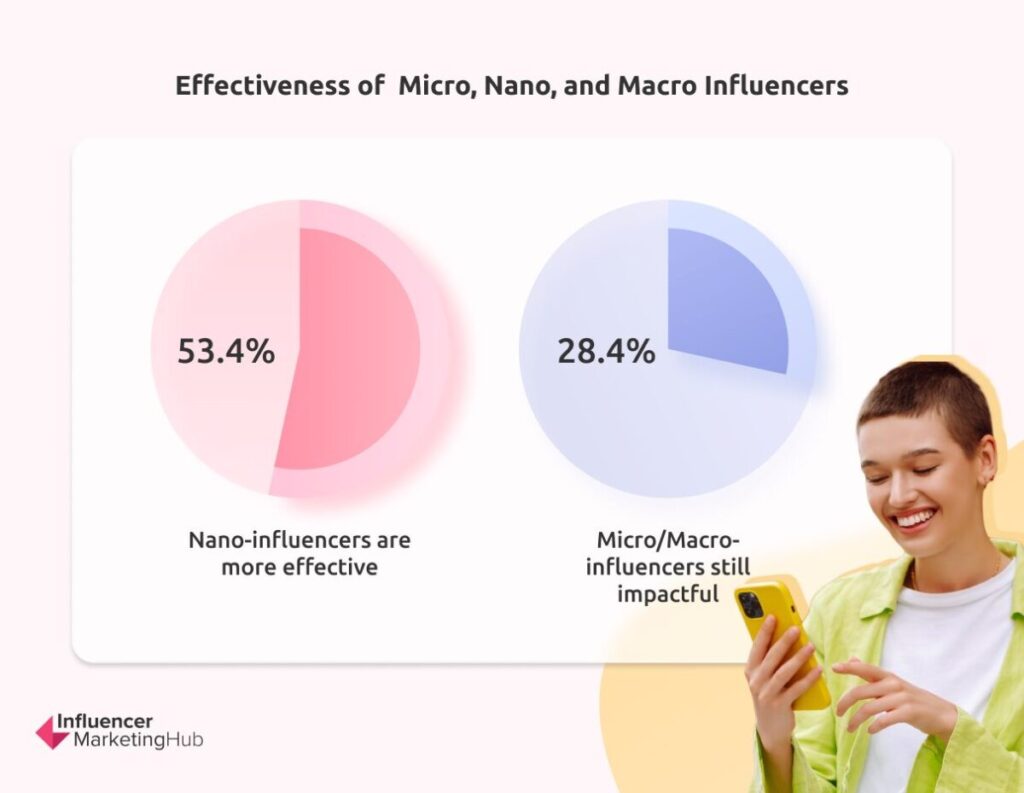
Budgeting for Impact: Why Nano-Influencers Are a Strategic Investment
The cost-benefit ratio of nano-influencers is another reason why brands should consider switching to them. Due to the fact that nano-influencers have significantly fewer followers than other influencers, cooperating with them is a more budget-friendly approach. It makes them more affordable for brands of any size and provides companies with an opportunity to diversify their marketing budget, thus, reaching wider audiences.
Therefore, it becomes more efficient for marketers to divide the budget among various influencers and run many low-cost but highly effective campaigns rather than partner with one celebrity.
The Magic of Niche Markets: Targeting the Right Audience
Another one of the most important benefits of using nano-influencers is that they target very specific and narrow markets. Unlike influencers with millions of followers who can send a message to a wider target audience, nano-influencers take their place in specific niches. Fashion, fitness, photography, or technology – these influencers understand their target market preferences and needs. When it comes to niche audiences, nano-influencers are a match made in heaven because they already have a high level of their audience’s attention.
This targeted approach means that brands aren’t just broadcasting their message to millions – they are getting to the right people – the people who might be interested in what they are selling. This approach leads to better leads and, therefore, better conversions.
A Relationship, Not Just a Transaction
The key difference of nano-influencers is the ability to build real, mutual connections with their audience. These influencers are likely to reply to comments, interact and even show interest in the audience’s opinion. It is this sort of interaction that makes influencers’ interaction with the audience more valuable which is different from the usual commercial promotions.
It allows brand managers to create a direct line of communication with their consumers. Instead of following the faceless influencer promoting a product, the followers get the impression that they are being directly messaged. The fact that word of mouth is 92% trusted more than any form of advertising is not news to anyone anymore. Nano-influencers, who are friendly and relatable, are the perfect link to this trust.
The Future of Influencer Marketing: Reclaiming Authenticity
Recently it became evident that the one-size-fits-all approach doesn’t bring the desired results anymore. It is not enough just to collaborate with a celebrity or a mega-influencer and expect that every follower will become interested in a promoted brand or product. The market of influencers has become oversaturated and people are becoming tired of constant ‘call-to-buy’ posts that they can see across all platforms. Opposite to that consumers are expecting to see authentic and trustworthy content from people they follow who they feel connected to.
Moreover, in most cases it is obvious that mega-influencers do not even use the products they promote, thus, they lose the trust of followers. This is why nano- and micro-influencers are becoming a new force in influencer marketing. They have a smaller number of followers, but they can truly be considered as communities of people who are closely connected to each other due to their common interests. Because of this stronger bond, they can provide higher engagement and better results.
The Power of Influencer Collaborations: Brands That Went Above and Beyond
Influencer marketing has turned out to be the secret weapon that brands cannot avoid using. Influencer campaigns are no longer just a method of gaining views but rather a way for brands to reach out to consumers, create organic conversations, and see outcomes. Let’s look at how brands of different sizes transform the concept of marketing with the help of nano- and micro-influencers.
Air Wick’s Sensational Rise Through Scent
The slogan of Air Wick is not only about fresh air; it is about fresh thinking. Last year, they released their Vibrant Scented Oils, and the product was promoted through an influencer marketing campaign. Partnering with lifestyle influencers, they brought their product into the everyday lives of potential customers. And it did – the engagement increased by 39%, due to the posts that were promoted by influencers across different platforms.
By repurposing influencer content, Air Wick was able to transform brand recognition into real outcomes. The result? A campaign that proved how even a smaller-scale influencer marketing initiative can hit the mark and drive quality engagement. A brilliant example of how a company can benefit from more specific targeting is Air Wick’s story. By using highly targeted marketing, it was able to become significantly more noticeable to customers and earn their trust.
Warby Parker: Eyewear with a Purpose
Warby Parker has never been just a stylish eyewear brand. By collaborating with celebrities and micro-influencers, the brand has created a community that represents more than just the glasses. Their #WarbyParker hashtag has been trending with over 250,000 posts on Instagram and 800,000 people reached.
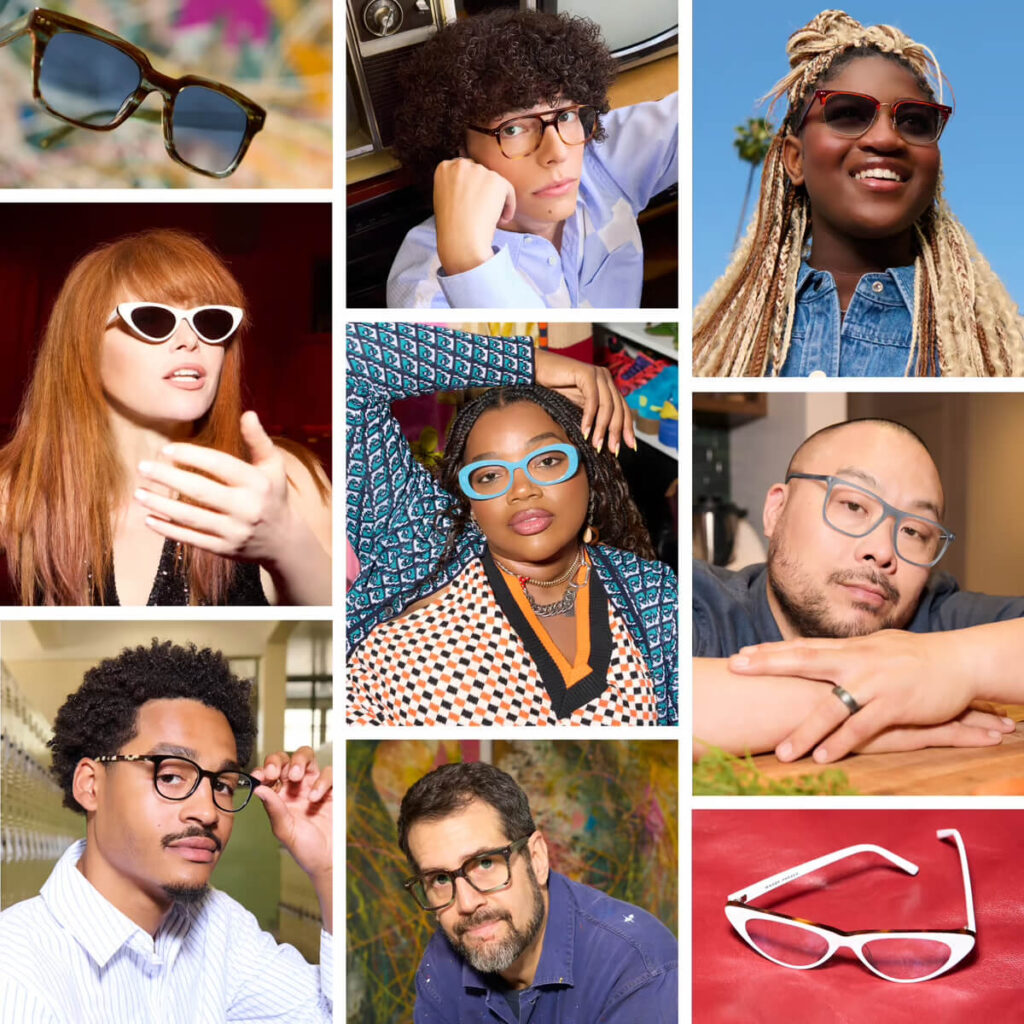
When Warby Parker added a ‘buy one, give one’ initiative to their campaign, they were not only raising awareness but also selling glasses through their influencer marketing. The outcome was impressive: 200 times more reach and better sales figures showed that the concept of purposeful marketing is effective. By engaging the micro-influencers, Warby Parker was able to reach out to their target audience in a way that was not only selling a product but also selling a message.
Maybelline’s Viral Hit: The Power of Micro-Influencers
Maybelline Superstay Vinyl Ink lipstick didn’t just launch quietly—it became a hit online, thanks to the right use of influencers, which is an important of Maybelline’s marketing strategy. The brand collaborated with micro makeup and lifestyle influencers to make videos with the product and present all the different types and colors of the product in an appealing manner. The result? One of the most successful products that later on became a best seller product of Maybelline.
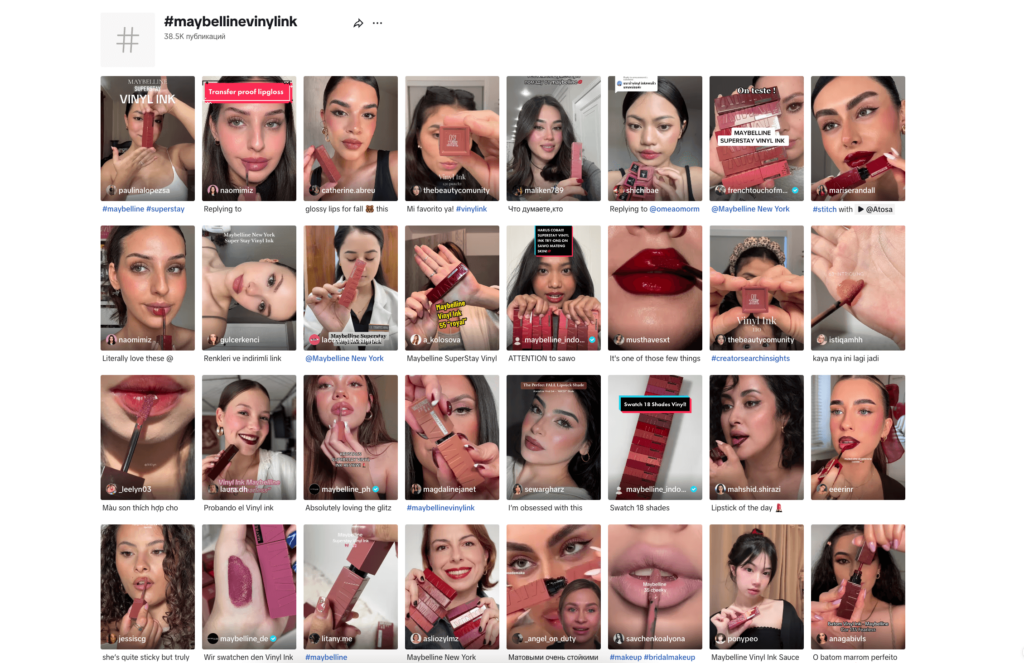
What set this campaign apart was not only the celebrities pushing the message, but the micro-influencers. Their audiences were smaller but more engaged and interested, which helped the product gain attention and win the hearts of customers. As the hashtag #maybellinevinylink spread, more people shared their own posts about the lipstick. This campaign proved that collaborating with micro-influencers not only is effective but is also the best strategy to use when looking to increase sales.
Fashion Nova: From Micro-Influencers to Mega Fame
When Fashion Nova started using influencer marketing, they decided to focus on micro influencers and it might be one of the best examples of an influencer marketing campaign. Starting with micro-influencers a campaign grew gradually but quickly to reach the level when a brand was able to partner with such celebrities as Kylie Jenner. The campaign became a huge success and led to unbelievable growth – 21 million followers across social media platforms and counting.
However, all of these impressive results would be impossible without the input of niche micro-influencers at the initial stages of the campaign. They promoted products, attracted the attention of customers, and made the brand start over the market.
Fashion Nova’s case proves that influencer marketing is highly effective even when the company invests a small amount of money at the beginning. Since each post received thousands of likes and comments, the brand transformed each piece of content into a brand asset that was used over and over again.
Nykaa’s Authentic Connection with #BeautyUnfiltered
India’s beauty retailer Nykaa followed a different approach with the #BeautyUnfiltered campaign. Instead of working with celebrities, they collaborated with micro-influencers to ensure that they get real users’ experiences. Unlike other celebrities who may just talk about their skincare routine or pose with products – these influencers were sharing stories of how they use products. It created the authenticity that standard advertising normally lacks and increased the level of trustworthiness in the products.
This approach paid off: Nykaa reported a 35% increase in website traffic and 20% in sales in one month. The use of real stories, especially with the help of micro-influencers, results not only in engagement but in actual conversion. The consumers relied on word of their favorite niche influencers and it boosted the sales as expected.
L’Oréal Transformation with Nano-Influencers
L’Oréal went for a strategic move when launching their anti-spot range, Bright Reveal, by collaborating with 810 nano-influencers. These influencers, all of whom appeared to have a genuine interest in beauty, shared their own stories of before and after. The result? More than 2,700,000 impressions across social networks, 98% of people recommended it, and 85% of people wanted to buy it.
This campaign is a good example of how the use of nano-influencers can be effective in generating a great amount of high-quality content. L’Oréal was able to establish brand credibility and achieve both online and offline sales by targeting influencers who were truly associated with the products.
So!Flow by Vis Plantis: Micro-Influencers with Major Impact
When Vis Plantis decided to launch so!flow, a haircare product line, they understood that being real was important, especially for a new growing product. The campaign’s objective was not only to increase sales but also to expand the brand’s visibility online by generating authentic interest and creating valuable content from consumers.
They partnered with 1,000 micro-influencers who not only promoted the product but also explained to their followers why it is good to use it. The brand ambassadors posted 1,892 different posts, which reached 13,260,000 people. 99% of the participants in the campaign also stated that they were ready to recommend so!flow products, while 97% said they would be willing to buy the products in the future.
The Takeaway: Influencer Marketing Is More Than Just Numbers
What these campaigns have in common is the move from the thinking ‘the more followers the better’ and shifting towards quality over quantity. Whether it’s Air Wick’s successful engagement with lifestyle influencers or L’Oréal’s focus on nano-influencers, the message is clear: influencer marketing is not about how many people you can reach but about how many of the right people can actually see and pay attention to what is advertised.
Influencer marketing has already been undergoing significant changes and will continue to evolve. What’s next? The possibilities are endless, but the key to success remains the same: genuineness, interactivity, and narrative.




















